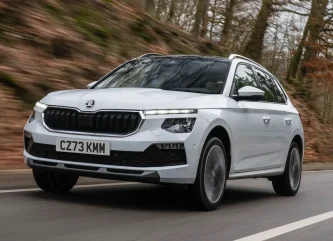
The Skoda Kamiq first arrived in 2019, forming the entry point to the manufacturer’s three-pronged SUV line-up, below the larger Karoq and Kodiaq. Of this trio, the Kamiq has become the best-seller, as well as Skoda’s second best-selling car overall – a success story which the manufacturer will be hoping to continue with the newly facelifted version tested here.
Many of the updates concern the Kamiq’s exterior styling, including a larger front grille, redesigned headlights and tail lights, and a silver diffuser. Matrix LED headlights are
newly available.
The interior features new fabric materials, and we would say our test car – in the European Selection spec, closely aligned with the mid-range SE L equipment grade in the UK – was decently trimmed, although the front seat passenger’s environment is more plasticky than the driver’s. An 8.25in infotainment screen – up from 6.5in pre-facelift – and 8in driver display are now standard with entry-level Kamiqs, while the rest of the range gets a 9.2in infotainment screen and a 10.25in driver display, and an upgraded climate control panel is also provided. Overall, this control set-up looks good – the larger driver display in particular is visually impressive – and works well.
One of the most impressive features of the Kamiq’s interior is rear legroom, which is plentiful. Headroom back there is decent too, even with a sunroof fitted to our test car (Monte Carlo spec is fitted with the sunroof in the UK). The 400-litre boot benefits from an essentially flat load lip, and is a good size, although slightly down on the largest B-segment rivals.
Mechanically, the main changes with the updated Kamiq range can be found under the bonnet. Three petrol engines are available – 1.0-litre options offering 95hp or 116hp, and a 1.5-litre with 150hp. This is very similar to the pre-facelift line-up, barring a small power increase for the more powerful 1.0-litre engine, but tweaks have been made to improve power delivery and efficiency, including the installation of new injectors and a new catalytic converter.
We tested the 1.5-litre engine, which features cylinder deactivation technology, dropping from running on four to two cylinders where possible to save fuel. Skoda says the range of driving conditions where this happens has now been extended, and software upgrades mean the system operates more smoothly – we certainly weren’t disturbed by it on the road, although more generally this engine does give some audible notice of how hard it’s working under heavy acceleration. Performance is pretty good at any rate for an SUV.
Unusually these days, the seven-speed DSG automatic transmission of our test car was paired with a manual handbrake – five and six-speed manual gearboxes are also available depending on spec.
No chassis changes have been carried out with the facelift. The Kamiq offers safe and reliable handling, although it’s not as dynamic a drive as the likes of the Ford Puma, while ride quality is decent. We were impressed on our test drive by the optional predictive adaptive cruise control, which does an impressive job of altering the car’s speed, not only for upcoming speed limit changes, but also for bends in the road.
Overall, although it’s probably fair to describe the updates to the Kamiq as modest, it remains a solid and highly practical choice.
Positive: Lots of space in the back, clever engine
Negative: Updates could be more substantial, lack of wow factor
Skoda Kamiq 1.5 TSI SE L DSG
P11D: £29,655
Residual value: 39.1%
Depreciation: £17.670
Fuel: £8,518
Service, maintenance and repair: £2,124
Cost per mile: 47.18p
Fuel consumption: 47.7mpg
CO2 (BIK %): 134g/km (31%)
BIK 20/40% a month: £153/£306
Luggage capacity: 400 litres
Engine size/power: 1,498cc/150hp
Score: 8/10





